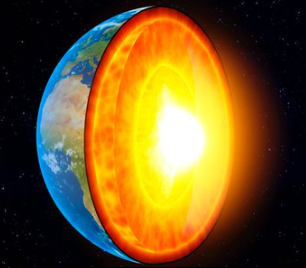Scientists are not sure it will happen, but we may very well get a change of 2 second. That’s it, so not very eventful…
A recent study has found compelling evidence that the Earth’s inner core has been slowing down its rotation relative to the planet’s surface since 2010, which could potentially alter the length of a day by fractions of a second. This slowdown marks the first significant change in the core’s behavior in many decades and adds a new layer of complexity to our understanding of Earth’s geophysical dynamics.
The Earth’s inner core is a solid sphere composed primarily of iron and nickel, nestled within the molten metal of the liquid outer core. It’s held in place by gravity and is integral to the functioning of Earth’s magnetic field. Historically, the core has been studied indirectly through seismology, particularly by analyzing seismograms, which are recordings of waves generated by earthquakes.
Earth’s inner core rotation is slowing down, making our days a bit longer: Scientists at the University of Southern California have discovered that Earth’s inner core, a solid iron-nickel sphere, is slowing down. https://t.co/qVJ7rmMvsy #EarthDotCom #EarthSnap #Earth pic.twitter.com/OojjRTbHQz
— Earth.com (@EarthDotCom) June 15, 2024
John Vidale, a professor of Earth Sciences at the University of Southern California and the corresponding author of the study published in the journal Nature, expressed initial surprise at the findings. The evidence, based on multiple seismogram observations, conclusively shows a deceleration of the inner core’s spin. This revelation is significant because, until recently, some scientists believed the inner core rotated faster than the Earth’s surface.
This deceleration might be linked to complex interactions between the magnetic field created in the outer core and gravitational effects from the Earth’s mantle. These dynamics are thought to influence the speed and direction of the inner core’s rotation. Indeed, the study suggests that the core is reversing or backtracking relative to the surface, rotating slower than the mantle for the first time in about 40 years.
Additional findings from other researchers, including Duncan Agnew, a geophysicist at the University of California San Diego, support the notion that changes in Earth’s physical structure, such as the climate change-driven melting of polar ice, are impacting global timekeeping. Agnew’s research indicates that the melting ice is affecting Earth’s rotation, leading to adjustments in how ‘leap seconds’ are added to Coordinated Universal Time (UTC) to keep up with the discrepancies in Earth’s rotation speed.
University of Southern California scientists have proven that the Earth’s inner core is backtracking, slowing down, began decreasing its speed around 2010, and moving slower in relation to the planet’s surface, as shown in new research published in Nature. pic.twitter.com/ZPrPM0KFQ7
— Neil Hadyn Nicholson (@neilnicholson) June 15, 2024
For the recent study, researchers analyzed seismic data from 121 repeating earthquakes from 1991 to 2023 in the South Sandwich Islands, a region known for its seismic activity. This data, combined with records from Soviet nuclear tests between 1971 and 1974 and other nuclear tests from France and America, provided a robust dataset for examining changes in the inner core.
Key Points:
i. A recent study has found that the Earth’s inner core has been slowing down since 2010, which could alter the length of a day by fractions of a second.
ii. The inner core, composed of iron and nickel, is crucial for generating Earth’s magnetic field and is studied indirectly through seismology.
iii. The slowdown could be influenced by interactions between the magnetic field and gravitational effects from the Earth’s mantle.
iv. Additional research links changes in Earth’s rotation to climate-induced ice melting, affecting global timekeeping and the necessity for ‘leap seconds’ in Coordinated Universal Time (UTC).
v. The study utilized seismic data from repeating earthquakes and historical nuclear test records to analyze the inner core’s dynamics.
Al Santana – Reprinted with permission of Whatfinger News



